DMM BTMeter BT-570C-APP
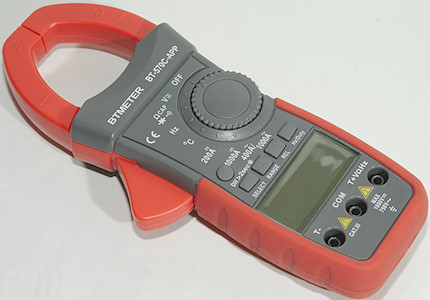
This is a DC clamp meter with common DMM functions and a Bluetooth interface and app.


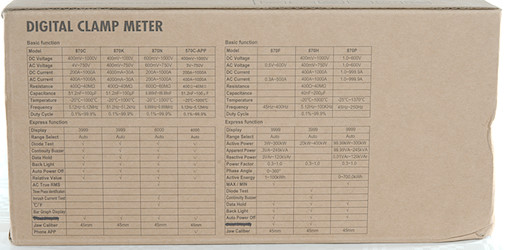

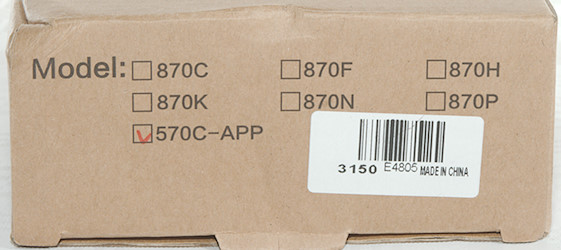
The box is for a lot of different meters and there is a comparison list on the back.
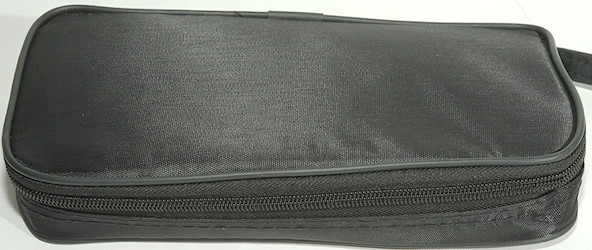
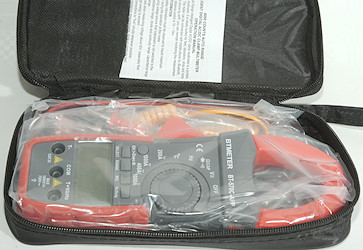
Inside the box is a pouch with everything in it.
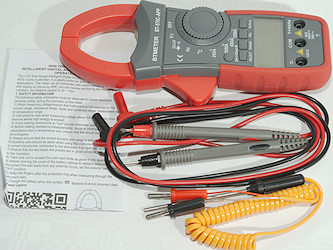
The package included the DMM, a pair of probes, a thermocoupler and a manual in addition to the pouch.


The probes are without any tip covers, this means the CAT III rating is wrong.

The plug is shrouded.


The thermocoupler is designed for insertion into stuff and is with a banana plugs-
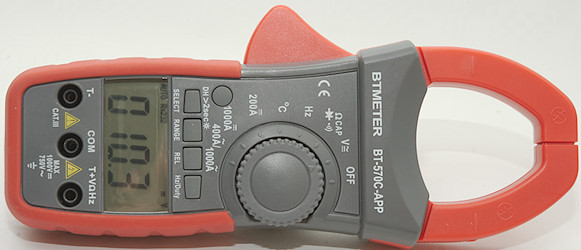

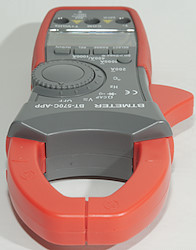




Display

All the segments on the display.
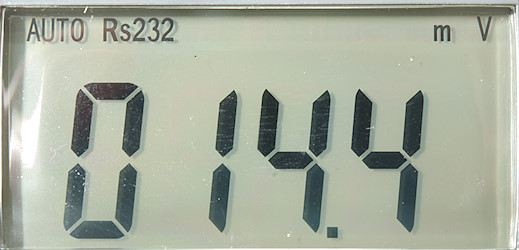
Typical display during usage with the range and the value. The RS232 is always on and is used for Bluetooth connection.
Functions

Buttons:
- DH: Freezes the display reading, hold down for backlight.
- Select: Select VAC and ohm/diode/continuity/capacitance
- Range: Select and change manual range, hold down to return to auto range.
- Rel: Shows values relative to current value, will also select manual range. Press again to disable.
- Hz/Duty: Select frequency and duty cycle in volt mode and change between frequency and duty cycle in Hz mode.
Rotary switch:
- Off: Meter is turned off
- V: Voltage AC and DC
 : Ohm/Continuity/Diode/Capacitance
: Ohm/Continuity/Diode/Capacitance
- Hz: Frequency and duty cycle mode.
- °C: Temperature, only in Celsius.
- 200ADC: The low DC current range, it will show values up to 400A
- 1000ADC: The high DC current range.
- 400/1000AAC: Both AC ranges
Input

The clamp is for current measurements, it can go around ø45mm, but it will touch.
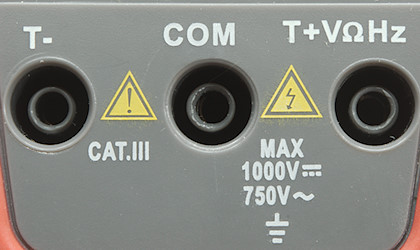
- T-: Minus terminal for temperature.
- COM: The common terminal for all ranges except temperature.
- xxx: All ranges except current.
Measurements
- Volt and frequency
- At 1Vrms frequency counter range is from 0.6Hz to 60MHz
- Frequency counter input do not requires a zero crossing.
- At 100mVrms V input frequency counter range is from 0.9Hz to 2.7kHz
- At 1Vrms V input frequency counter range is from 0.6Hz to 23kHz
- Frequency V input requires a zero crossing
- Duty cycle on V input works from 20% to 80% at 1kHz with 4Vpp, precision is within 16.0
- Duty cycle on frequency input works from 1% to 99% at 100kHz with 1Vpp, precision is within 0.2
- 1 VAC is 5% down at 2kHz.
- Input impedance is between 10 and 11Mohm on DC and AC
- Input impedance is high on mVDC and will drop to 10Mohm above 2V.
- Overload protection is rated to 1000VDC/750VAC, frequency is 250VDC/AC
- Current
- Overload protection is rated to 1000A for 60 seconds.
- Ohm, Continuity, diode and capacitance
- Ohm needs about 4s to measure 100ohm
- Ohm is 0.44V open and 0.2mA shorted
- Continuity is moderate (Below 150ms mostly much faster).
- Continuity beeps when resistance is below 50ohm and makes noise up to 65ohm.
- Continuity is 0.44V open and 0.2mA shorted
- Diode range uses 1.5V, max. display is 0.999V at 0.19mA, max. current is 0.6mA shorted
- 10uF takes about 3.5 seconds to measure.
- 100uF takes about 18 seconds to measure.
- Overload protection is rated to 250VDC/AC
- Miscellaneous
- Current consumption of meter is 1.4mA to 2.1mA with terminal input and 4.9mA with clamp input (With backlight is it 46mA).
- Meter works down to 2.4V where it turns off, battery symbol show at 3.7V.
- Clamp reading is stable down to 6V then it will start dropping, 1 VDC starts dropping at 2.2V, meter turns off at 2.4V
- Backlight fades slowly with falling voltage and is off at 3.7V.
- The meter usual need a couple of display update to reach the final value.
- Viewing angle is good, except from the top.
- Display updates around 3 times/sec
- Neither backlight nor meter will automatic turn off.
- Standard probes can be pushed fully down, but my Keysight was very tight.
- Weight is 365g without accessories, but batteries.
- Size is 227 x 94 x 37mm with rubber sleeve.
- Probes
- Standard probe resistance 47mOhm for one.
- Standard probe wire is 100cm long.

A look at the capacitance measurement waveform.

Frequency input resistance depends on input voltage.
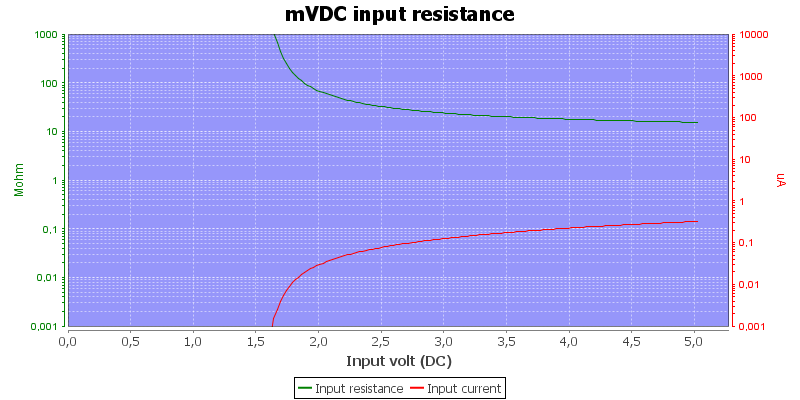
The mVDC range is high impedance, until the protection clamps.

200A range will show values up to 400A
Even with REL the 50nF range is 0.3nF out.
Android application
The application must be downloaded from a Chinese website and installed locally.

The startup picture for the application, to start just press Start, I did not have to do any matching for it to work.

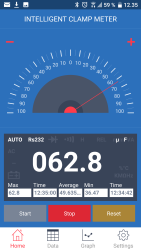
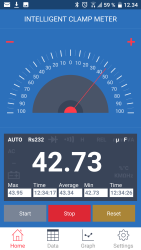
After pressing start it will show a analog value using either a 40 or a 100 scale and the digital value with captured min and max values.
Going out of Bluetooth range and into range again lost some data, but not the connection.
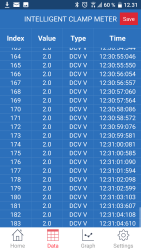
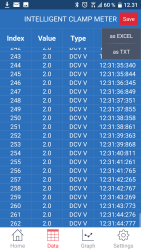
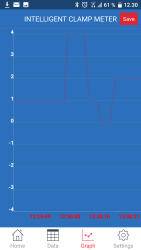
Sweeping sideways or using the buttons at the bottom it is possible to get a table or curve. The table can be saved in text format, Excel did not work.



The option page allows adjustment of the sample rate and there is a about page.

The saved text format uses date-time as filename, this means it is possible to save many logs. The format is plain text with spaces between elements.
Tear down

3 screws and the meter was open
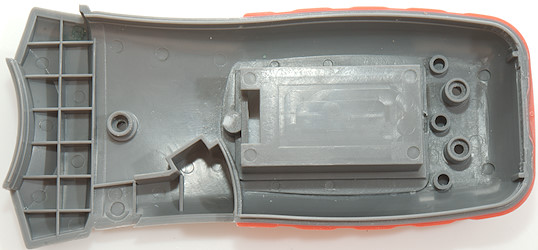
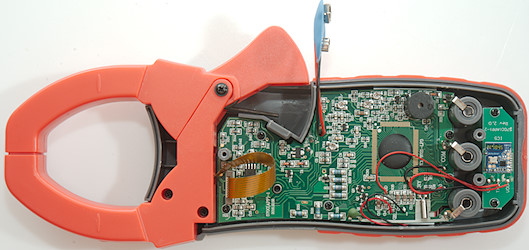
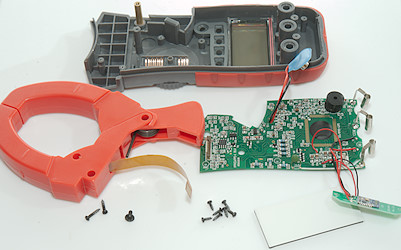
I had a little problem taking out the circuit board, the clamp must be removed first. I first discovered that after removing all the 5 screws in the circuit board and 2 in the Bluetooth module. The clamp was 3 screws.
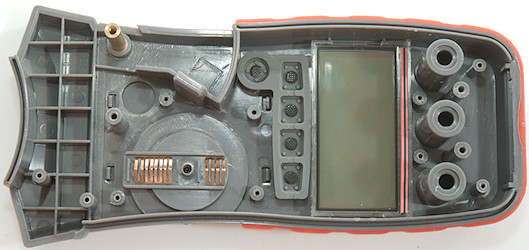

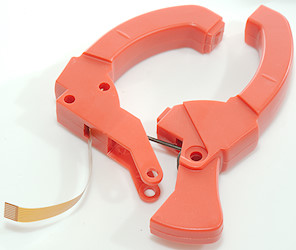
The clamp is two sealed parts with the sensors in one part.

For the clamp input is a OpAmp (IC4: TL052C Dual low offset OpAmp), with two voltage regulators (IC2 & IC3: 75301: 3.0V) nearby, probably one for the OpAmp and one for the rest of the meter.
The input terminal goes directly to a PTC followed by the input resistors (R28 & R29: 2x5Mohm), but the PTC is bypassed for the another resistor (R33: 900kOhm) and just after the PTC there is a track directly to the range switch. In ohm the input through the PTC is connected to a clamp transistor (T5) at the range selection resistors. The frequency and temperature input use the PTC, a capacitor parallel with a resistor (C8 & R21: 100kOhms) and then to the chip.
There is a few diodes (Q1, Q2, Q3) for range switch encoding. The main chip (IC1: FS9721-LP3) is a 4000 count multimeter chip.
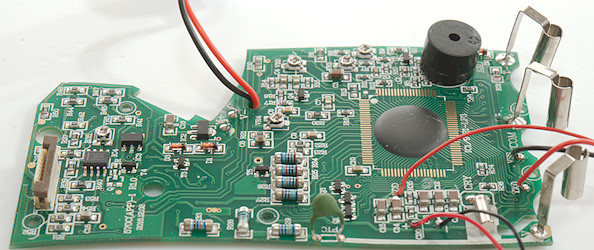
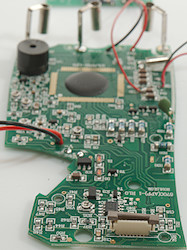
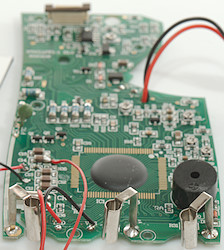

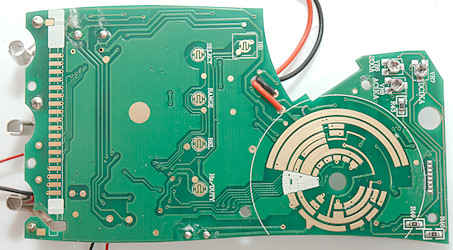
On this side is the pads for the LCD, the rotary switch and the buttons, but there is also some trim pots? How is they adjusted?


A closer inspection of the enclosure showed how, there is a cover that can be removed.
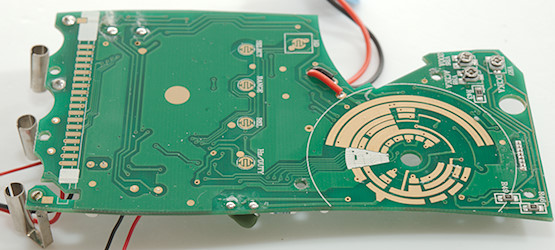

The Bluetooth module is a small Bluetooth module on a circuit board, it uses a Dialog DA14580 chip.


Conclusion
As usual the protection is not up to a CAT III rating, it will probably work at mains voltage, but transients will kill the meter.
The meter works, a minor detail is bad calibration on the low capacity range, a more serious problem is that the meter will show wrong values due to low battery, before it reports a low battery.
The Bluetooth was easy to get working, but the export format could be better.
With the high current ranges the meter is mostly for high power applications and the safety is not good enough for that!
Notes
How do I review a DMM
More DMM reviews
 : Ohm/Continuity/Diode/Capacitance
: Ohm/Continuity/Diode/Capacitance
























 : Ohm/Continuity/Diode/Capacitance
: Ohm/Continuity/Diode/Capacitance



































